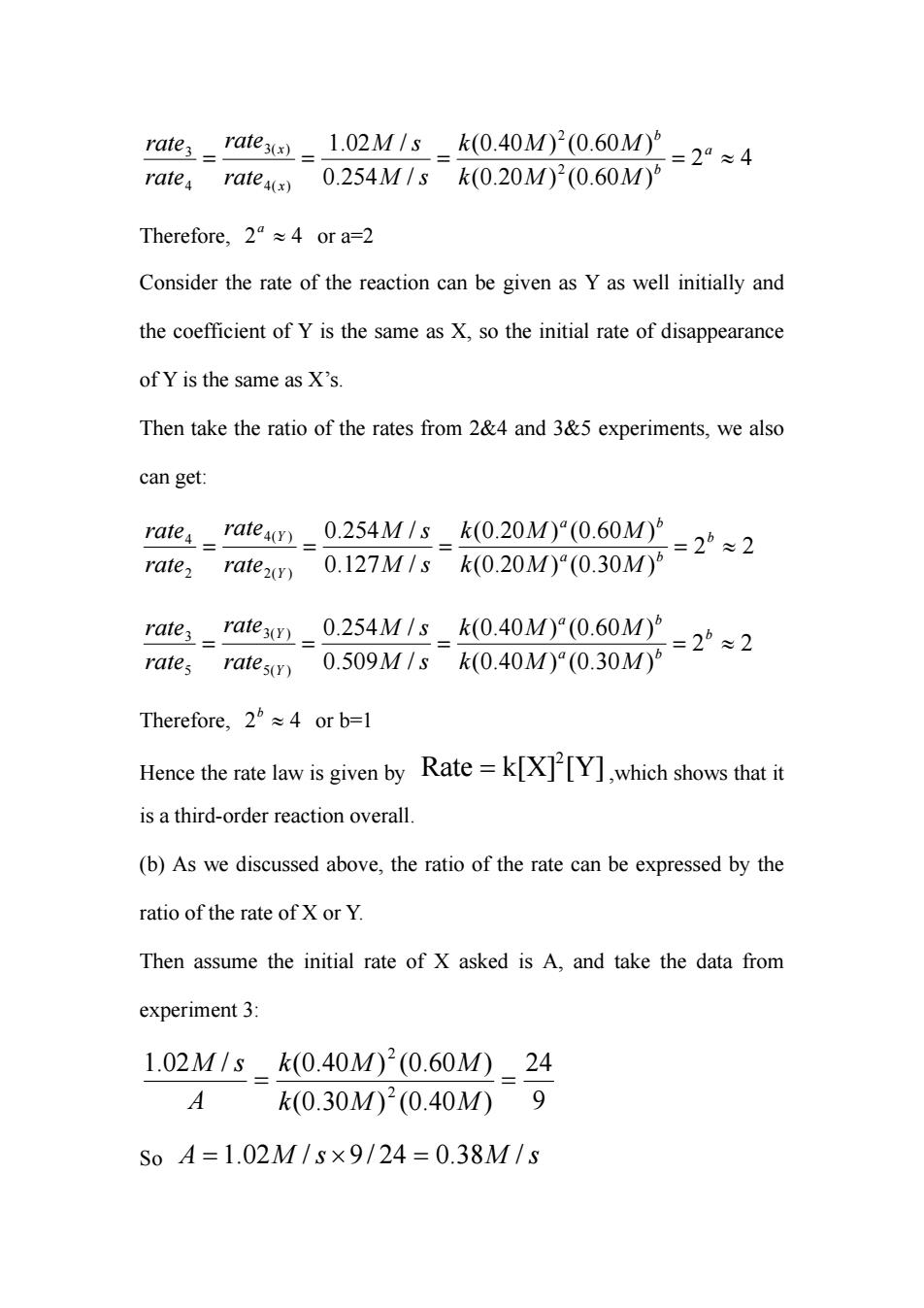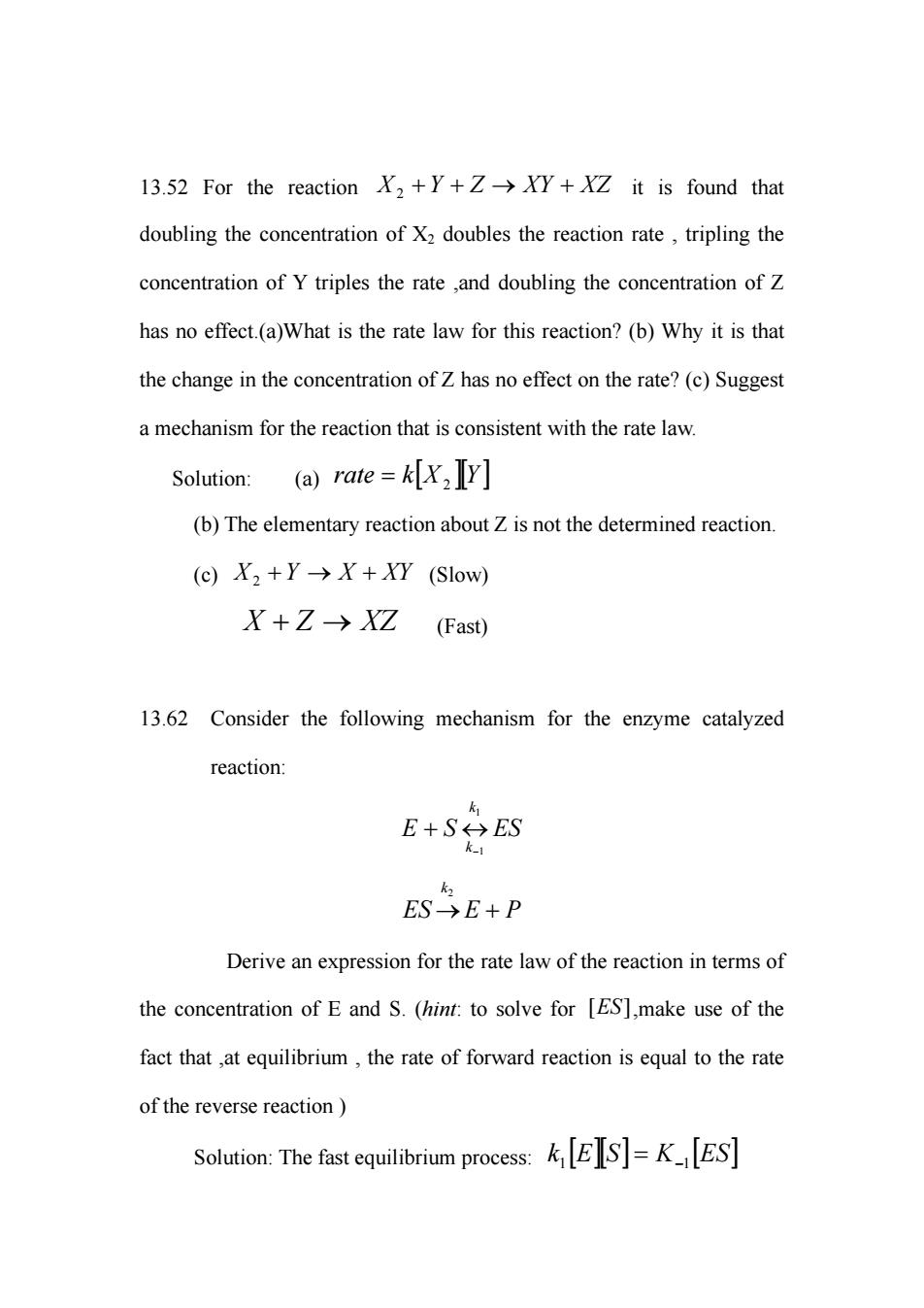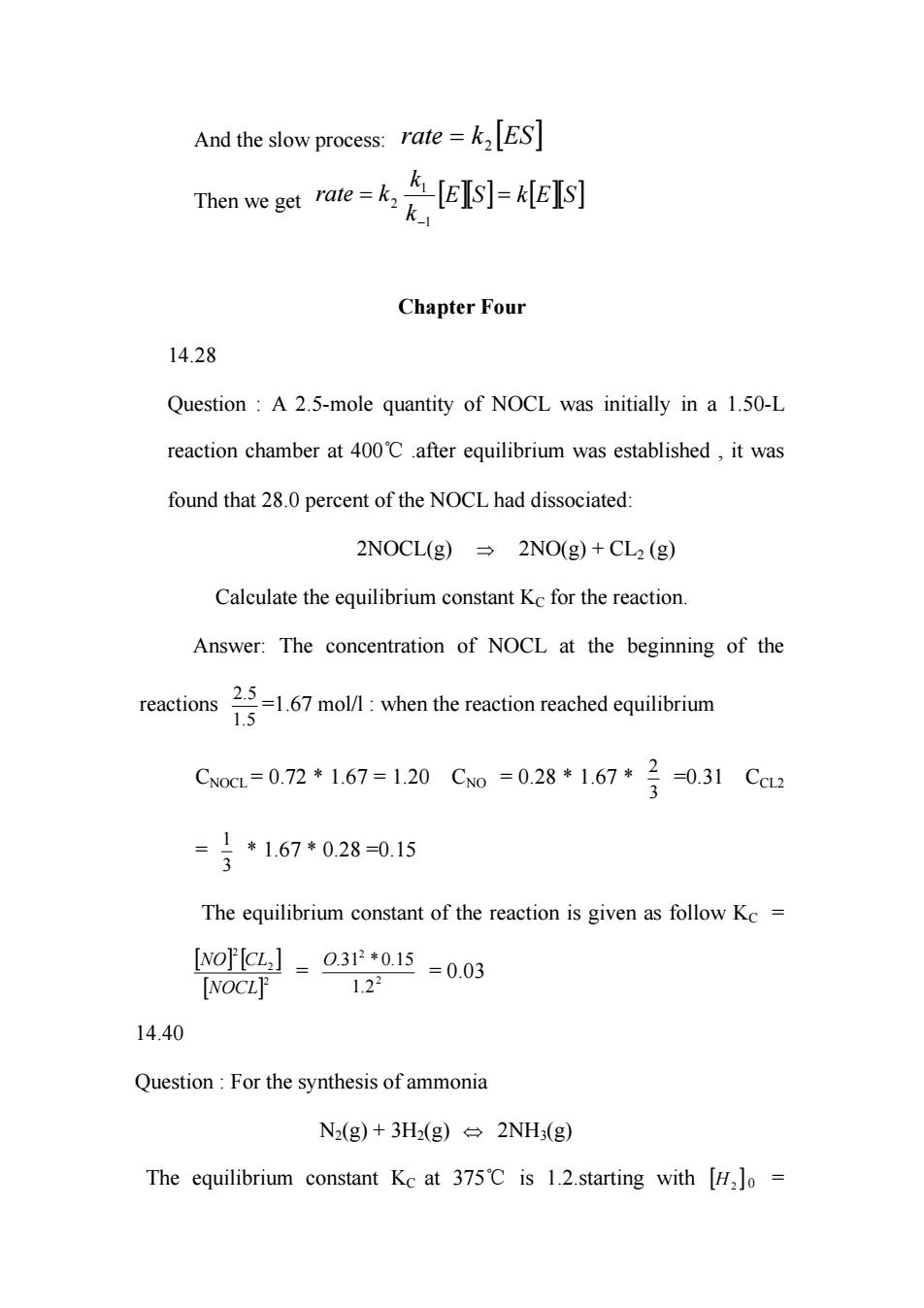
rae3-ae3=1.02M/s-k(0.40M)2(0.60M =24≈4 rate,rate()0.254M/s k(0.20M)2(0.60M) Therefore,2a≈4ora=2 Consider the rate of the reaction can be given as Y as well initially and the coefficient of Y is the same as X,so the initial rate of disappearance of Y is the same as X's. Then take the ratio of the rates from 2&4 and 3&5 experiments,we also can get: rate=ae4n=0.254M/s-k(0.20M)°(0.60M0 =26≈2 ratez ratez)0.127M/s k(0.20M)(0.30M) ae=aem=0.254M/s_k0.40MP(0.60M rae,rates0.509M1sk(0.40M°(0.30M0° =2”≈2 Therefore,.2≈4orb-l Hence the rate law is given by Rate=k[X[Y],which shows that it is a third-order reaction overall. (b)As we discussed above,the ratio of the rate can be expressed by the ratio of the rate of X or Y. Then assume the initial rate of X asked is A,and take the data from experiment 3: 1.02M/sk(0.40M)2(0.60M)24 A k(0.30M02(0.40M)9 S0A=1.02M/s×9/24=0.38M/s
42 )60.0()20.0( )60.0()40.0( /254.0 /02.1 2 2 )(4 )(3 4 3 == = ≈= a b b x x MMk MMk sM sM rate rate rate rate ≈ 42a Therefore, or a=2 Consider the rate of the reaction can be given as Y as well initially and the coefficient of Y is the same as X, so the initial rate of disappearance of Y is the same as X’s. Then take the ratio of the rates from 2&4 and 3&5 experiments, we also can get: 22 )30.0()20.0( )60.0()20.0( /127.0 /254.0 )(2 )(4 2 4 == = ≈= b a b a b Y Y MMk MMk sM sM rate rate rate rate 22 )30.0()40.0( )60.0()40.0( /509.0 /254.0 )(5 )(3 5 3 == = ≈= b a b a b Y Y MMk MMk sM sM rate rate rate rate ≈ 42b Therefore, or b=1 Hence the rate law is given by ,which shows that it is a third-order reaction overall. [Y]k[X]Rate 2 = (b) As we discussed above, the ratio of the rate can be expressed by the ratio of the rate of X or Y. Then assume the initial rate of X asked is A, and take the data from experiment 3: 9 24 )40.0()30.0( )60.0()40.0(/02.1 2 2 = = MMk MMk A sM So = sMA × = /38.024/9/02.1 sM

13.52 For the reaction2++Z+it is found that doubling the concentration of X2 doubles the reaction rate,tripling the concentration of Y triples the rate ,and doubling the concentration of Z has no effect.(a)What is the rate law for this reaction?(b)Why it is that the change in the concentration ofZ has no effect on the rate?(c)Suggest a mechanism for the reaction that is consistent with the rate law Solution:(a)rate=k[X2IY] (b)The elementary reaction about Z is not the determined reaction. (c)X2+Y>X+XY (Slow) X+Z→XZ(Fast) 13.62 Consider the following mechanism for the enzyme catalyzed reaction: E+S分ES ES>E+P Derive an expression for the rate law of the reaction in terms of the concentration of E and S.(hint:to solve for [ES],make use of the fact that,at equilibrium,the rate of forward reaction is equal to the rate of the reverse reaction) Solution:The fast equilibrium process:k]=KES]
13.52 For the reaction 2 + + → + XZXYZYX it is found that doubling the concentration of X2 doubles the reaction rate , tripling the concentration of Y triples the rate ,and doubling the concentration of Z has no effect.(a)What is the rate law for this reaction? (b) Why it is that the change in the concentration of Z has no effect on the rate? (c) Suggest a mechanism for the reaction that is consistent with the rate law. [ ][YXkrate ] Solution: (a) = 2 (b) The elementary reaction about Z is not the determined reaction. (c) +→+ XYXYX (Slow) 2 + → XZZX (Fast) 13.62 Consider the following mechanism for the enzyme catalyzed reaction: ESSE k k 1 −1 ↔+ PEES k +→ 2 Derive an expression for the rate law of the reaction in terms of the concentration of E and S. (hint: to solve for ,make use of the fact that ,at equilibrium , the rate of forward reaction is equal to the rate of the reverse reaction ) ES][ [ ][ ] [ESKSEk1 −1 Solution: The fast equilibrium process: = ]

And the slow process:rate=kES] Then we get rale=k,车Gy-ke时 k Chapter Four 14.28 Question:A 2.5-mole quantity of NOCL was initially in a 1.50-L reaction chamber at 400C .after equilibrium was established,it was found that 28.0 percent of the NOCL had dissociated: 2NOCL(g)2NO(g)+CL2(g) Calculate the equilibrium constant Kc for the reaction. Answer:The concentration of NOCL at the beginning of the Cw0=0.72*167=120C0=028*1.67*号-031Cc =号167*028=0.15 The equilibrium constant of the reaction is given as follow Kc= [ojCl_032*015=0.03 NOCL 1.22 14.40 Question:For the synthesis of ammonia N2(g)+3Hg)=2NH3(g) The equilibrium constant Kc at 375C is 1.2.starting with [H]o=
[ESkrate ] And the slow process: = 2 [ ][ ] [ ][ ] SEkSE k k = krate = −1 1 Then we get 2 Chapter Four 14.28 Question : A 2.5-mole quantity of NOCL was initially in a 1.50-L reaction chamber at 400℃ .after equilibrium was established , it was found that 28.0 percent of the NOCL had dissociated: 2NOCL(g) ⇒ 2NO(g) + CL2 (g) Calculate the equilibrium constant KC for the reaction. Answer: The concentration of NOCL at the beginning of the reactions 5.1 5.2 =1.67 mol/l : when the reaction reached equilibrium 3 2 CNOCL = 0.72 * 1.67 = 1.20 CNO = 0.28 * 1.67 * =0.31 CCL2 3 1 = * 1.67 * 0.28 =0.15 The equilibrium constant of the reaction is given as follow KC = [ ][ [ ] ] 2 2 2 NOCL CLNO 2 2 2.1 O 15.0*31. = = 0.03 14.40 Question : For the synthesis of ammonia N2(g) + 3H2(g) ⇔ 2NH3(g) [H2 The equilibrium constant KC at 375 is 1.2.starting with ℃ ] 0 =